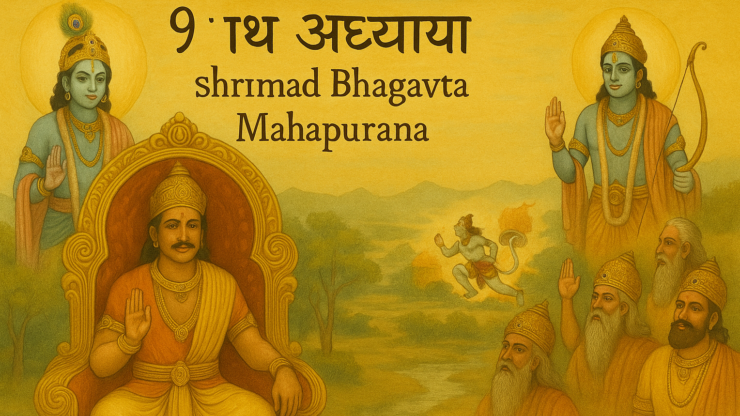The Shrimad Bhagavata Mahapurana is not just a scripture — it’s a journey through time, wisdom, and the timeless play of the Divine. Every canto (skandha) and chapter (adhyaya) is a layer of spiritual, philosophical, and historical revelation. Among these, the 9th Adhyaya (Chapter) of the 9th Skandha (Book) stands out as a powerful bridge between divine stories and dynastic legacies, especially as it prepares us for the upcoming tales of Lord Krishna.
Table of Contents
Let’s explore the essence of the 9th Adhyaya and why it matters, not just in the flow of the Purana, but in the heart of every seeker.

Setting the Stage: Lineages of the Solar Dynasty
The 9th Skandha primarily focuses on the genealogies of kings and dynasties, especially the famed Suryavamsa (Solar Dynasty) and Chandravamsa (Lunar Dynasty). These genealogies are not just historical records; they are spiritual blueprints. They show how dharma (righteousness) is preserved and how divine principles can be practiced even in worldly roles like kingship.
In Adhyaya 9, we continue to dive deeper into the lives of great kings who were not only administrators of the land but also caretakers of dharma. Some of these kings were renowned for their renunciation, some for their bravery, and others for their devotion to God.
Highlighting the Lineage of Lord Rama
One of the key features of this Adhyaya is its elaboration on the descendants of Ikshvaku, the founding father of the Solar Dynasty. From him, we are led to the story of King Harishchandra, celebrated for his unwavering commitment to truth and righteousness, even in the face of immense suffering.
But more importantly, we are brought to the mention of Lord Rama, the Maryada Purushottam — the perfect human being, born into this very dynasty. While the detailed narration of Rama’s story comes in other scriptures like the Ramayana, the Bhagavata Purana acknowledges and reveres his role in establishing divine dharma on Earth.
This Adhyaya reminds us that divinity can manifest in dynasties, and that even the most human roles — like that of a king, a son, or a husband — can be infused with godly qualities if lived with integrity and love.
The Rise and Fall of Kings: Lessons from the Lunar Dynasty
As the Adhyaya transitions, it begins to describe the Chandravamsa, or the Lunar Dynasty, which eventually gives birth to the Yadu Dynasty — the family into which Lord Krishna is born. We read about kings like Pururava, who falls in love with the celestial Apsara Urvashi, highlighting the play of love, longing, and detachment even in divine lives.
What’s interesting is how these stories are not judgmental. The Purana doesn’t glorify only the flawless; instead, it presents kings with all their emotions, struggles, and imperfections. Some fall into pride, others into lust or arrogance — but redemption, repentance, and devotion are always possible. The human experience is honored as a stepping stone to the divine.
This honesty is what makes the Shrimad Bhagavatam so relatable. It doesn’t ask us to be perfect — it shows us that even kings and sages fell and rose again through faith, humility, and service to the Lord.
The Spiritual Thread: Dharma is the Backbone
If there’s one lesson this Adhyaya keeps repeating, it’s this: Dharma sustains everything.
Despite the grandeur of palaces, armies, and conquests, the ultimate strength of any dynasty — and by extension, any society — is its commitment to truth, compassion, self-control, and service. Whether it’s King Ambarisha’s story of devotion or Harishchandra’s trial by fire, the central message is that dharma is not just a duty — it is the very foundation of spiritual evolution.
When kings followed dharma, prosperity and peace flourished. When they deviated, chaos took over. The cosmic law was always in motion.
What Makes This Chapter So Human
Unlike many parts of the Purana that speak of cosmic battles, magical boons, or divine incarnations, this chapter brings us stories of real choices made by real rulers — choices between greed and generosity, lust and love, revenge and forgiveness.
This Adhyaya is where mythology meets psychology. It shows how human nature remains consistent, even over millennia. We are all faced with dilemmas. We all long for legacy, love, and meaning. And through these stories, the Purana whispers — “You’re not alone in your struggle. Even kings have walked this path.”
Why It Matters Today
In a time when leadership is often measured by popularity or power, the 9th Adhyaya calls us back to ethical and spiritual leadership. It reminds us that to rule others, one must first rule the self.
Whether you’re a student, a professional, a parent, or a teacher — you are a leader in your own world. And these stories are not just about ancient kings — they are mirrors of the choices we make every day.
- Will we speak the truth, even when it’s hard?
- Will we honor our responsibilities, even when it costs us?
- Will we turn to the Divine, even when surrounded by distractions?
These are the questions the 9th Adhyaya gently places in our hearts.
Looking Ahead: The Arrival of Lord Krishna
As the dynasties evolve and histories unfold, this Adhyaya slowly leads us closer to the arrival of Lord Krishna, who is born into the Yadu lineage — a branch of the Lunar Dynasty. While Krishna’s divine play begins in the next chapters, this one sets the stage by showing the karma, dharma, and choices of his ancestors.
The stories serve as a spiritual prelude — like clouds gathering before the rain — hinting at the immense divine intervention that is about to take place in the world.
Conclusion: More than History, It’s a Legacy
The 9th Adhyaya of the Shrimad Bhagavata Mahapurana is not just a record of kings and kingdoms. It is a living scripture that speaks to our deepest selves — reminding us that every life, no matter how royal or ordinary, is a part of the Divine Plan.
It teaches us that:
- Power without humility is hollow.
- Dharma, once lost, is hard to regain.
- And above all, devotion (bhakti) purifies everything — even the gravest of errors.
In its humble storytelling, this chapter offers us an invitation — to reflect, to rise, and to remember that we too are part of a divine lineage, meant not just to live, but to uplift.


